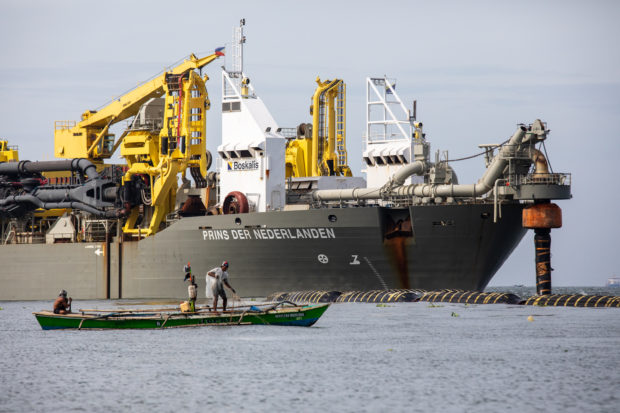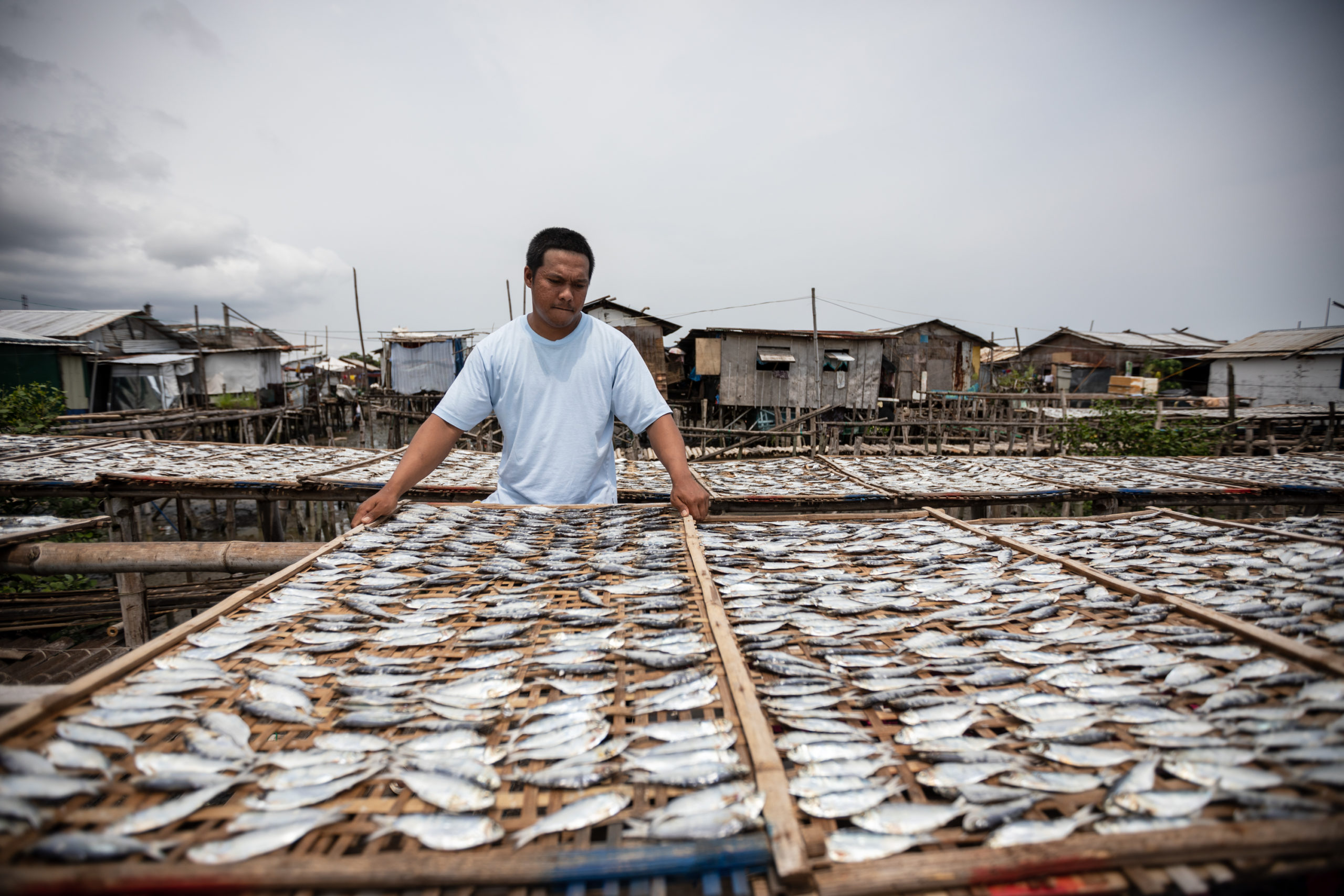
WE THINK THE FISH HAVE LEFT’ | Fishermen from Bataan province encounter one of the massive vessels anchored on Manila Bay as it extracts sand from the seabed. Local fishers have lately seen an increase in quarrying activities that reduce their catch and destroy known hatching grounds, they said. (Photo by KATHLEEN LEI LIMAYO / Contributor)
MANILA, Philippines — Before daybreak, Edwin Rosales, 33, would set out for Manila Bay to find the best spots to cast his net for “alubaybay,” a variety of sardines and a major income-earner in his coastal village in Limay, Bataan province, a supplier of “tuyo” (dried fish) for markets in Metro Manila.
Having learned the ways of the sea from his father and grandfather, Rosales remembered a time when he didn’t have to go far in his motorboat for a good catch within Limay’s local waters. But in recent years he had been forced to venture farther out to Bulacan or Cavite provinces, with the haul getting smaller and paying little for the extra effort.
He and other longtime fishermen in the village agreed that the dwindling yield may be due to overfishing. But recently another, more disturbing factor emerged.
In Cavite, a number of large vessels had entered the old fishing grounds, dredging the seafloor and filling their bellies with wet sand, before sailing off and leaving a wrecked marine ecosystem in their wake.
On at least two occasions, Rosales said, the dredgers “ran over my net because I couldn’t get out of their way fast enough.”
“Before they arrived, we were free to fish there. The sadder part was that they chose the spots that were known to be hatching grounds,” he added. “Now that they have mined those areas, we think the fish have left.’’
Fisherfolk and environmental advocates blamed Rosales’ plight on what they considered the “evil twins” now doing damage on Manila Bay away from public gaze: quarrying and reclamations.
They noted an increase in seabed mining activities — or the extraction of mud, silt, and sand from the seafloor — since April 2021 after then President Rodrigo Duterte lifted the nine-year moratorium on mineral agreements, undoing Executive Order No. 79 that was issued during the Benigno Aquino III presidency.
According to the Environmental Management Bureau (EMB), dredging operations in various areas of the bay currently cover about 13,530 hectares.
The EMB confirmed two ongoing operations in the bay, both in the coastal waters of Cavite: the San Nicolas Shoal Seabed Quarry Project of VIL Mines Inc. (active since 2022 and covering some 8,530 ha), and the Seabed Quarry Project of the Philippine Reclamation Authority (beginning in 2021 and covering 5,000 ha).
In Limay, Bataan, Cargon Mining Corp. applied for a permit in 2020 to extract some 77 million tons of sand, according to the bureau.
The following year, however, the Bureau of Fisheries and Aquatic Resources (BFAR) denied Cargon’s application for area clearance, as well as that of 12 other companies. In rejecting them, the bureau said it “cannot simply dismiss the potential adverse impacts of seabed quarrying on fisheries.”
“Further degradation [of] fisheries habitats in Manila Bay and the rest of our fishing grounds will surely result in depletion in fisheries biodiversity,” the BFAR explained.
Aware of the BFAR rejections, Rosales and his colleagues were thus puzzled by the continued presence of dredgers in the bay.
They were not being “territorial,” he said. “We share our area and we don’t bar others from coming here; as long as you are a fisherman you can partake of what the sea can offer.”
“But because of the quarrying, the reclamations, it’s getting crowded here… So many businesses are crowding us out of the bay,’’ said Rosales, who heads the local chapter of the fisherfolk group Pangisda.
A DAY IN A LIFE Every day, the fisherfolk of Bataan province set out to sea in the Manila Bay to survive. Lately, however, seabed quarrying and reclamation activities have shrunk their fishing grounds. – PHOTOS BY KATHLEEN LEI LIMAYO
In an email interview last week, then EMB Director William Cunado said the agency allowed the quarrying operations of VIL Mines and the PRA since they had complied with the requirement to introduce “mitigating measures,” like the installation of silt curtains and oil spill arresters to control pollution, and the establishment of buffer zones along the coastline and nearshore seabeds.
According to the environmental impact statements (EIS) submitted by the VIL and PRA to the EMB, the filling materials extracted by both operations were intended for government reclamation projects, including the 265-ha Pasay Reclamation Project near the SM Mall of Asia complex and the new international airport planned in Taliptip, Bulacan.
In its EIS, a copy of which was obtained by the Inquirer, VIL Mines also promised to keep off valuable fishing grounds and implement “social development and management plans” to provide alternative sources of livelihood for any displaced fishermen.
The company also said it would set aside P115 million to fund livelihood, educational and health programs for the affected coastal communities.
‘MANILA BAY ISLAND’ Earth-moving equipment is seen atop this mound of sand in front of the Philippine Senate, actually a reclamation project by the Pasay city government. – PHOTOS BY KATHLEEN LEI LIMAYO
But for the fisherfolk of Limay, those promised programs offered little assurance and could not supplant their way of life.
Angelo Dula, 39, said he could no longer go to some of his usual fishing areas near Malabon City, Cavite and Bulacan since the quarrying started. Many of those areas, he said, were known hatching grounds for sardines and threadfin bream (“bisugo”).
Like Rosales, Dula said he had encountered the dredging vessels up close when they dislodged his nets and laid his day’s work to waste. (Most Limay fishermen use gillnets, locally known as “panyo,” which cost around P6,000 per set.)
“They would just run over our nets like they own the sea; they don’t care at all,” he said. “They don’t even try to avoid them.”
Elpidio dela Cruz, another local fisherman, said the disturbed sediment could cling to their nets “like snot and it’s not easy to remove.”

HARDSHIPS Angelo Dula, a fisherman from Limay, has been fishing on Manila Bay since he was 14. Where before a single journey could earn them P800, now two trips can get them enough fish only to earn at least P400. –PHOTOS BY KATHLEEN LEI LIMAYO
Quarrying basically leaves the seafloor too muddy for fish to stay, said Fernando Siringan, a marine scientist from the University of the Philippines-Marine Science Institute (UPMSI).
Scooping out the sand could also release “dormant cysts of red tide species” that were already embedded harmlessly in the seabed, he said. In the right conditions, the cysts could reproduce and repopulate the water surface, causing algal blooms that are toxic to marine life.
“These are the kinds of considerations that should have been measured and weighed against the benefits of scraping the seabed,” Siringan said. “Because the consequences would not just affect the communities in offshore Bataan but everybody using Manila Bay.”
Gloria Estenzo-Ramos, vice president of the marine conservationist group Oceana Philippines, added: “We know that if you do seabed quarrying, you’re destroying what’s there. There should be transparency but we’re not seeing any of that.”
But the worst effects of seabed mining may be too subtle or incremental to be immediately seen and felt.
Siringan said the coastal erosion currently taking place in Cavite may be traceable to seabed mining in San Nicolas dating back to the 1970s. A UPMSI study touching on this correlation is in progress.
Materials obtained from quarrying activities during the period were used for reclamation projects covering wide swathes of Manila Bay, including areas that now host the Manila Film Center, the Folk Arts Theater and the Rizal Park, among others, he said.
Communities near reclaimed or quarried areas should be aware that as the water becomes deeper because of the extractions, waves can penetrate coastlines with their ‘’full energy,’’ making the local population more vulnerable to the impact of typhoons, which are then amplified by climate change, he added.
(This story was produced with the support of Internews’ Earth Journalism Network.)